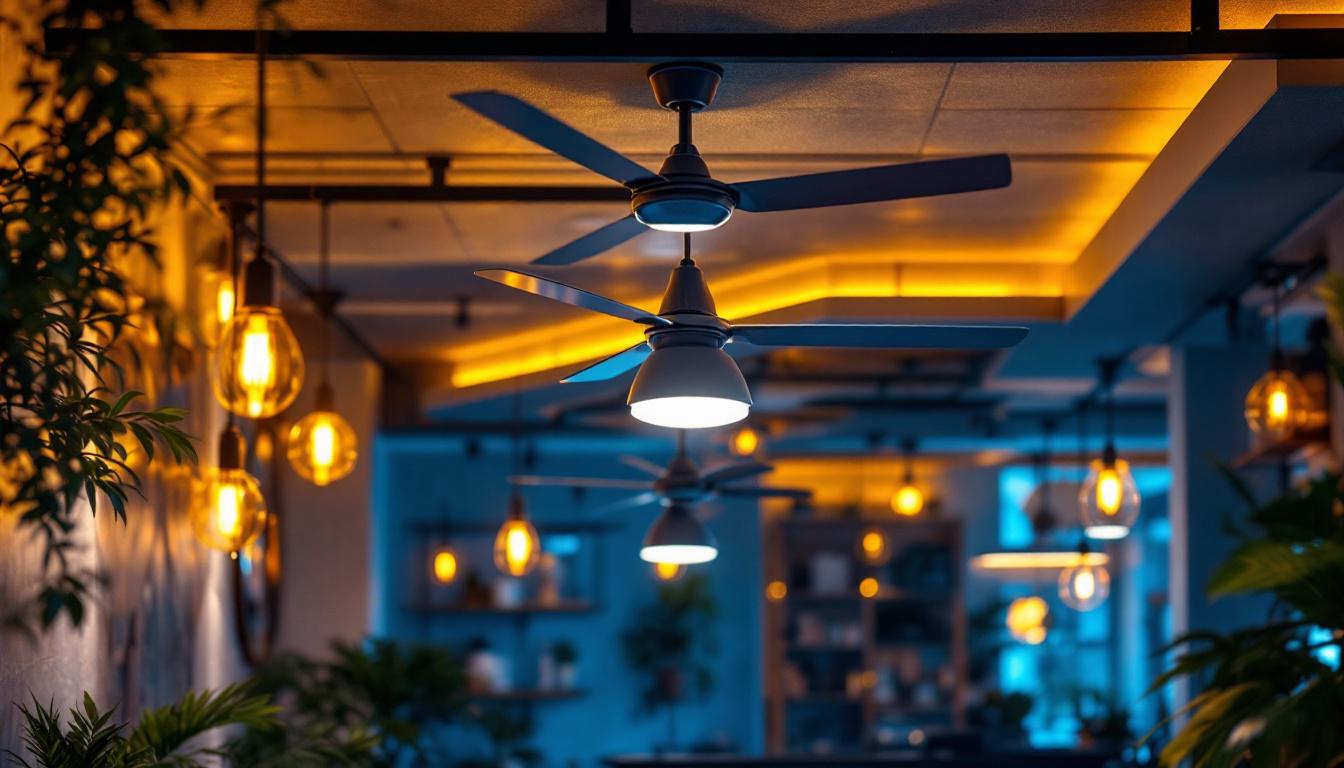
In the realm of commercial lighting installation, the integration of ceiling fans is often overlooked. However, these fans play a crucial role in enhancing both the functionality and aesthetics of a space. By understanding how commercial ceiling fans can complement lighting projects, contractors can provide a more comprehensive solution to their clients.
Ceiling fans are not just about air circulation; they can significantly influence the overall ambiance of a room. When paired with the right lighting, they can create a harmonious environment that enhances comfort and productivity. The synergy between lighting and ceiling fans can also help in reducing energy costs, as the fans can distribute warm air during colder months and create a cooling effect during the summer, allowing for a more balanced temperature throughout the year.
Moreover, the design of commercial ceiling fans has evolved significantly, offering a variety of styles, sizes, and finishes that can suit any commercial space, from sleek and modern to classic and ornate. This versatility allows businesses to choose fans that not only meet functional requirements but also align with their brand identity and interior design. For instance, a trendy café might opt for industrial-style fans to complement its rustic decor, while a corporate office may choose minimalist fans that blend seamlessly with contemporary furnishings. The right ceiling fan can thus become a statement piece that enhances the overall design narrative of the space.
Additionally, advancements in technology have introduced smart ceiling fans that can be controlled via mobile apps or integrated with smart building systems. This feature allows for greater convenience and energy efficiency, as users can adjust fan settings based on occupancy or time of day. Such innovations not only improve user experience but also contribute to sustainability efforts, making commercial ceiling fans an essential consideration in modern commercial environments. As businesses increasingly prioritize eco-friendly solutions, the role of ceiling fans in reducing reliance on HVAC systems becomes even more significant, further solidifying their place in commercial lighting and design strategies.
One of the primary advantages of installing ceiling fans in commercial spaces is the improvement in air circulation. Proper air movement can make a room feel more comfortable, reducing the reliance on air conditioning systems. This not only leads to energy savings but also creates a more pleasant environment for employees and customers alike.
When lighting contractors consider the airflow dynamics in a space, they can strategically position ceiling fans to work in tandem with lighting fixtures. This ensures that the light is evenly distributed throughout the area, minimizing shadows and enhancing visibility.
Energy efficiency is a significant concern for many businesses today. By incorporating ceiling fans into lighting installation projects, contractors can help their clients reduce energy consumption. Ceiling fans can help distribute warm air during colder months and cool air during warmer months, allowing HVAC systems to operate more efficiently.
Moreover, modern ceiling fans are designed with energy-efficient motors and blades, which can significantly lower electricity costs. When paired with LED lighting, which consumes less energy than traditional bulbs, the overall energy footprint of a commercial space can be drastically reduced.
Ceiling fans come in a myriad of styles, sizes, and finishes, making them a versatile addition to any commercial space. Whether a business aims for a modern, sleek look or a more traditional aesthetic, there is a ceiling fan that can complement the design.
Lighting contractors can leverage this versatility by selecting fans that enhance the visual appeal of the lighting fixtures. A well-chosen ceiling fan can serve as a focal point in a room, drawing attention to the lighting while also providing functional benefits.
When selecting a ceiling fan for a commercial space, size and scale are paramount. A fan that is too small will struggle to provide adequate airflow, while one that is too large can overwhelm the room’s proportions. It’s essential to consider the dimensions of the space and the height of the ceiling when making this decision.
For larger areas, such as warehouses or open-plan offices, industrial-style fans with larger blades can effectively circulate air. In contrast, smaller, more decorative fans may be suitable for conference rooms or reception areas. Understanding the scale of the space will ensure that the chosen fan complements the lighting installation rather than detracting from it.
Beyond functionality, the aesthetic appeal of a ceiling fan should align with the overall design theme of the commercial space. Lighting contractors should consider the materials, colors, and finishes of both the ceiling fan and the lighting fixtures.
For instance, a sleek, modern ceiling fan with a brushed nickel finish can pair beautifully with contemporary LED fixtures. Conversely, a rustic wooden fan may enhance the charm of vintage-style lighting. By ensuring a cohesive design, contractors can elevate the overall look of the installation.
The performance of a ceiling fan is largely determined by its motor. High-quality fans typically feature energy-efficient motors that operate quietly and effectively. When selecting a fan, contractors should look for those with multiple speed settings and reverse functionality, allowing for year-round use.
Additionally, features such as remote control operation or smart technology integration can enhance user convenience. By recommending fans with advanced performance features, contractors can provide clients with a more sophisticated and user-friendly lighting solution.
Installing a ceiling fan requires careful attention to detail, particularly regarding mounting techniques. The fan must be securely attached to a ceiling joist or a fan-rated box to ensure safety and stability. Lighting contractors should always follow local building codes and manufacturer guidelines during installation.
Moreover, the height at which the fan is installed can affect its performance. Ideally, the fan blades should be positioned 8 to 9 feet above the floor for optimal airflow. Ensuring proper height not only enhances functionality but also complements the lighting setup, creating a balanced visual effect.
Electrical considerations are critical when integrating ceiling fans into lighting projects. Contractors must ensure that the electrical supply can handle the additional load of the fan. This may involve upgrading circuits or installing dedicated switches for the fan and lighting fixtures.
Additionally, proper wiring techniques are essential to prevent any electrical hazards. Using the correct gauge wire and ensuring secure connections will contribute to a safe and efficient installation. Proper planning in this phase can prevent future complications and ensure a seamless operation of both the lighting and fan systems.
Ultimately, the goal of integrating ceiling fans into lighting installation projects is to achieve a balance between aesthetics and functionality. Contractors should aim to create spaces that are not only visually appealing but also comfortable and efficient.
By considering the interplay between lighting and ceiling fans, contractors can design environments that enhance productivity and satisfaction. This holistic approach will not only meet client expectations but also foster long-term relationships built on quality and expertise.
In modern office environments, the combination of ceiling fans and lighting has proven to be highly effective. A recent project involved the renovation of an open-plan office where the goal was to create a more inviting atmosphere. By installing sleek, contemporary ceiling fans alongside energy-efficient LED lighting, the space transformed into a comfortable and productive work environment.
The ceiling fans not only improved air circulation but also complemented the lighting design, creating a cohesive and stylish look. Employees reported increased comfort levels, which in turn enhanced their productivity.
In retail settings, the integration of ceiling fans and lighting can significantly influence customer experience. A boutique clothing store recently underwent a redesign that included the installation of decorative ceiling fans paired with warm, ambient lighting. This combination created an inviting atmosphere that encouraged customers to linger longer.
The fans helped regulate the temperature, ensuring a comfortable shopping experience. The visual appeal of the fans also drew attention to the lighting, highlighting merchandise effectively and enhancing the overall aesthetic of the store.
In the hospitality industry, creating a welcoming environment is paramount. A recent hotel renovation showcased the successful integration of ceiling fans and lighting in common areas such as lobbies and dining spaces. The selected fans were stylish yet functional, providing comfort while enhancing the overall decor.
With strategically placed lighting fixtures highlighting architectural features and artwork, the fans added an extra layer of sophistication. Guests appreciated the comfortable atmosphere, which contributed to positive reviews and repeat visits.
The future of ceiling fans and lighting integration is undoubtedly leaning towards smart technology. With the rise of smart homes and buildings, the demand for interconnected systems is increasing. Ceiling fans equipped with smart features allow users to control both the fan and lighting from their smartphones or through voice commands.
This level of convenience not only enhances user experience but also promotes energy efficiency. Lighting contractors who stay ahead of these trends can offer clients cutting-edge solutions that align with modern expectations.
As sustainability becomes a priority for many businesses, the demand for eco-friendly ceiling fans and lighting solutions is on the rise. Contractors should consider recommending products made from sustainable materials and those that promote energy efficiency.
Additionally, integrating ceiling fans that utilize renewable energy sources, such as solar power, can further enhance a project’s sustainability profile. By focusing on environmentally friendly options, contractors can appeal to eco-conscious clients and contribute to a greener future.
Incorporating commercial ceiling fans into lighting installation projects offers numerous benefits that extend beyond mere aesthetics. From enhancing air circulation and energy efficiency to providing design versatility, these fans can significantly improve the overall functionality and appeal of a space.
By understanding the importance of proper selection, installation, and integration, lighting contractors can elevate their projects and deliver exceptional results to their clients. As trends continue to evolve, staying informed about new technologies and sustainable solutions will ensure that contractors remain competitive in the ever-changing landscape of commercial lighting.
Ultimately, the collaboration between ceiling fans and lighting can create environments that are not only visually stunning but also comfortable and efficient, paving the way for successful lighting installation projects.
Ready to enhance your lighting installation projects with the perfect commercial ceiling fans? Look no further than LumenWholesale, where we offer an exceptional range of spec-grade lighting products at unbeatable wholesale prices. Our commitment to quality and affordability ensures that you can provide your clients with the functionality and design versatility they desire, without the burden of inflated costs. Take advantage of our hassle-free bulk buying process, complete with free shipping, and elevate your commercial environments with ease. Experience the difference in quality, affordability, and convenience today by visiting Wholesale Lighting at the Best Value and make your next project a resounding success.

Discover expert tips and essential resources from top lighting contractors to master the art of hanging light fixtures.

Discover why LED shop lights are revolutionizing the lighting industry and what every contractor should know to stay ahead.

Discover the transformative power of LED canister light bulbs for lighting contractors.

Discover why lighting contractors should prioritize outdoor lighting projects in this insightful article.